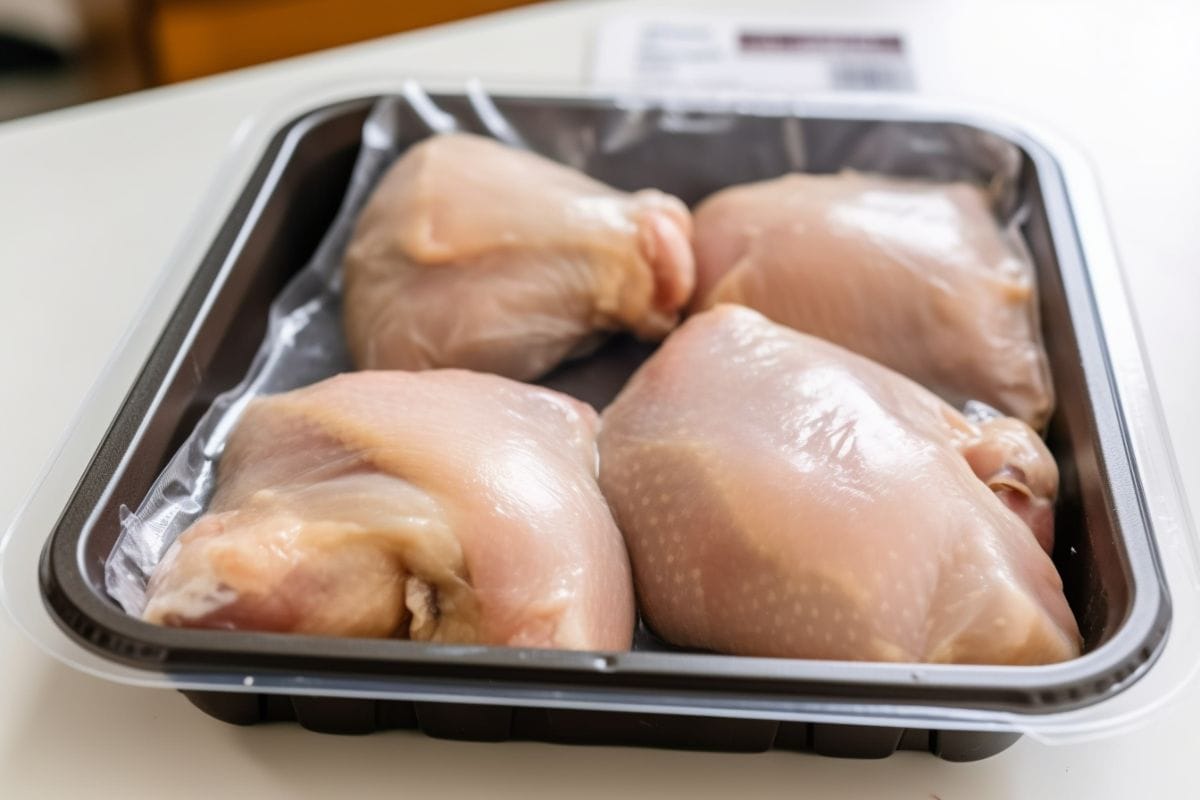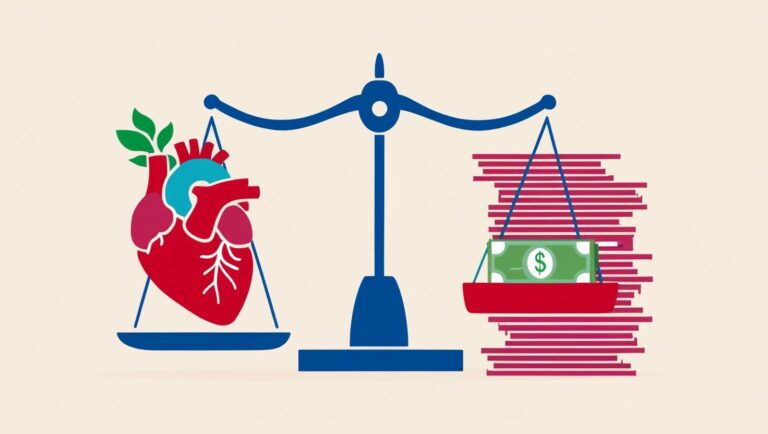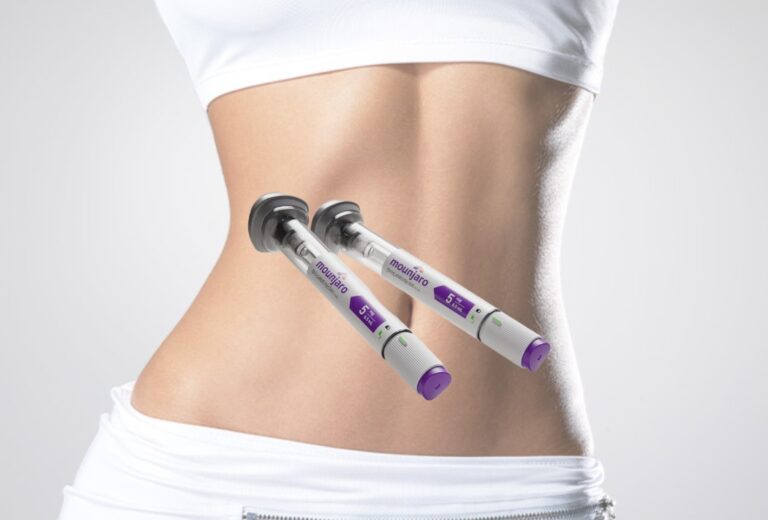When it comes to raw chicken, proper handling and storage are essential to ensure food safety. Leaving raw chicken out at room temperature for too long can lead to bacterial growth and increase the risk of foodborne illnesses.
In this article, we will explore the guidelines for leaving raw chicken out, the maximum time it can be left unrefrigerated, and when raw chicken becomes unsafe to consume.
According to the USDA, raw chicken should not be left out at room temperature for more than two hours. If the temperature in the room exceeds 90°F, the time limit decreases to one hour. Bacteria can multiply rapidly in the temperature range of 40°F to 140°F, known as the “danger zone.”
Therefore, it is crucial to handle raw chicken properly and store it at the appropriate temperature to prevent bacterial growth and foodborne illnesses.
Table of Contents
Key Takeaways:
- Raw chicken should not be left out at room temperature for more than two hours.
- The time limit decreases to one hour if the room temperature exceeds 90°F.
- Bacteria can multiply rapidly in the temperature range of 40°F to 140°F.
- Proper handling and storage of raw chicken are essential to prevent bacterial growth.
- Always refrigerate raw chicken promptly to maintain food safety.
The Danger Zone – 40°F and 140°F (4°C and 60°C)
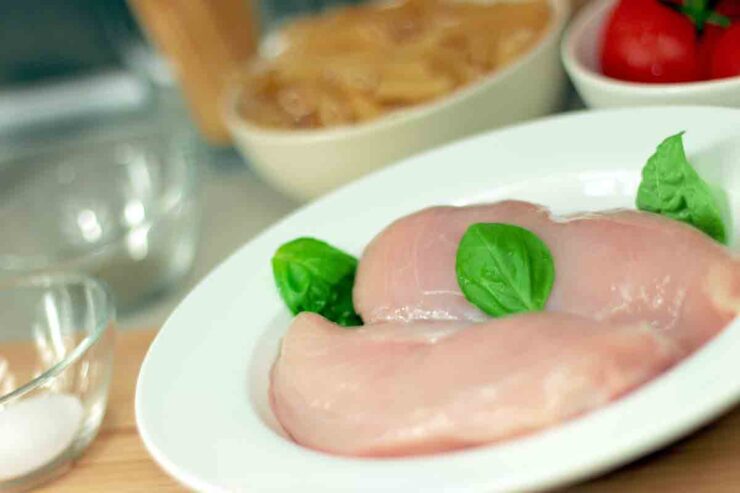
When it comes to food safety, understanding the danger zone is crucial. The danger zone refers to the temperature range between 40°F and 140°F (4°C and 60°C), in which bacteria can rapidly multiply. This temperature range provides the optimal conditions for bacterial growth and can lead to foodborne illnesses if proper precautions are not taken.
To prevent bacterial growth and ensure food safety, it is essential to keep hot foods above 140°F and cold foods below 40°F. Hot foods should be kept at a minimum temperature of 140°F or higher to inhibit bacterial growth, while cold foods should be stored at 40°F or below to slow down bacteria’s multiplication.
It is important to note that the danger zone is not only applicable to raw chicken but to all types of perishable food. When food is left within the danger zone for an extended period, bacteria can multiply rapidly, increasing the risk of foodborne illness.
This is why it is crucial to follow proper food safety guidelines and ensure that perishable foods, including raw chicken, are stored correctly and at safe temperatures to prevent bacterial growth and keep foodborne illnesses at bay.
By understanding the danger zone and taking the necessary precautions, we can protect our health and well-being. It is essential to handle and store raw chicken properly, follow safe temperature controls, and adhere to food safety guidelines to prevent the risk of foodborne illnesses.
Being aware of the danger zone and practicing proper food handling and storage is key to ensuring that our meals are safe, healthy, and enjoyable.
Proper Handling and Storage of Raw Chicken
When it comes to raw chicken, proper handling and storage are crucial for ensuring food safety. By following a few simple practices, you can minimize the risk of cross-contamination and bacterial growth.
To begin, always store raw chicken in the refrigerator at a temperature of 40°F or below. This helps to slow down the growth of bacteria and prevent foodborne illnesses. It’s important to keep raw chicken separate from other foods, especially ready-to-eat items, to avoid cross-contamination.
Use sealed containers or plastic bags to prevent any juices from leaking onto other foods. When it comes to freezing raw chicken, it’s best to do so as soon as possible after purchasing to maintain its quality. Chicken can be safely frozen for up to six months in a freezer set to 0°F or below.
To thaw frozen chicken, it’s recommended to do so in the refrigerator or using the defrost function on your microwave. Avoid thawing chicken at room temperature, as it can promote the growth of bacteria.
When reheating chicken, ensure it reaches an internal temperature of 165°F to kill any remaining bacteria. This can be done in the oven, on the stove, or using a microwave. It’s important to note that reheating chicken multiple times is not recommended, as it can lead to bacterial growth.
Instead, it’s best to thaw and cook only the amount of chicken needed to avoid any leftovers that may need to be reheated.

| Temperature Guidelines for Handling and Storing Raw Chicken | Temperature |
|---|---|
| Refrigerator | 40°F or below |
| Freezer | 0°F or below |
| Thawing | In the refrigerator or using defrost function |
| Reheating | Internal temperature of 165°F |
By following these proper handling and storage practices, you can ensure the safety of your raw chicken and minimize the risk of foodborne illnesses. Remember to always practice good hygiene, such as washing your hands thoroughly after handling raw chicken, to further reduce the risk of contamination.
Signs of Spoiled Chicken
When it comes to ensuring food safety, it is essential to be able to identify signs of spoiled chicken. Consuming spoiled chicken can lead to food poisoning and other health risks. By being aware of the following warning signs, you can avoid consuming chicken that has gone bad.
Poor Appearance
One of the first indicators of spoiled chicken is a change in appearance. Fresh chicken should have a pinkish color, but if it starts to turn gray or greenish, it is a sign that it has deteriorated. Additionally, if you notice any mold or strange discoloration on the chicken, it is best to discard it immediately.
Unpleasant Smell
The smell of chicken can also give you a clue about its freshness. Fresh chicken should have a mild odor or no smell at all. However, if you detect a strong, unpleasant, or sour smell coming from the chicken, it is a clear indication that it has spoiled and should not be consumed.
Unusual Texture
Another sign of spoiled chicken is a slimy or sticky texture. Fresh chicken should feel moist and firm to the touch. If the chicken feels slimy or sticky, it is a strong indication that bacteria have started to multiply, and it is no longer safe to eat.
Expiration Date
Always check the expiration date on the chicken packaging. If the date has passed, it is best to err on the side of caution and assume that the chicken is no longer safe to consume.
By paying attention to these signs of spoiled chicken, you can ensure that you and your loved ones consume only fresh and safe poultry.
Can Raw Chicken Sit Out for 3 Hours?
According to food safety guidelines, raw chicken should not be left out at room temperature for more than two hours. This is to prevent the growth and multiplication of bacteria, which can lead to foodborne illnesses.
However, if the room temperature exceeds 90°F, the time limit decreases to just one hour. It is essential to adhere to these recommendations to ensure the safety of the chicken and avoid any potential health risks.
Leaving raw chicken out for three hours can significantly increase the risk of bacterial contamination. Bacteria can multiply rapidly in the temperature range of 40°F to 140°F, known as the “danger zone.” This is where bacteria grow most rapidly and can reach unsafe levels in just a few hours. Therefore, it is crucial to handle and store raw chicken properly to minimize the risk of foodborne illnesses.
When it comes to raw chicken, it is always better to be safe than sorry. If raw chicken has been left out for three hours or longer, it is no longer safe to consume.
Consuming chicken that has been left out for an extended period increases the likelihood of food poisoning and can lead to severe illness. To ensure food safety, it is recommended to discard any raw chicken that has been left out for three hours or more.
| Time | Room Temperature | Safety |
|---|---|---|
| 2 hours or less | Below 90°F | Safe to consume |
| 1 hour or less | Above 90°F | Safe to consume |
| 3 hours or more | Any temperature | Not safe to consume |
It is crucial to prioritize food safety when it comes to handling and storing raw chicken. Always keep raw chicken refrigerated and avoid leaving it out at room temperature for extended periods. By following these guidelines, you can minimize the risk of foodborne illnesses and ensure the safety of your meals.
Is It Okay if Raw Chicken Is Left Out Overnight?
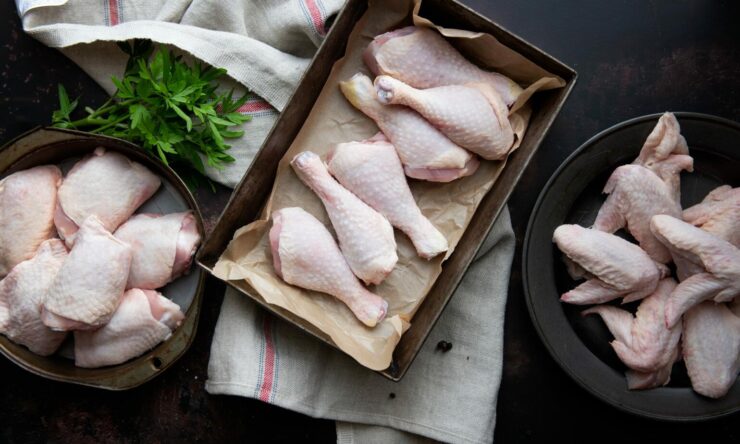
No, it is not safe to leave raw chicken out overnight. Raw chicken should always be stored in the refrigerator or freezer to prevent bacterial growth and foodborne illnesses. Bacteria can multiply rapidly at room temperature, increasing the risk of food poisoning if consumed.
For food safety, raw chicken should be properly stored and discarded if left out for extended periods.
Leaving raw chicken out for prolonged periods can lead to the growth of harmful bacteria, such as Salmonella or Campylobacter. These bacteria thrive in the temperature danger zone, which is between 40°F and 140°F (4°C and 60°C).
By practicing proper food handling and storage procedures, you can ensure that your chicken remains safe for consumption. Always refrigerate or freeze raw chicken promptly and discard any leftovers that have been left out for an extended period. This will help to reduce the risk of food poisoning and ensure the safety of your meals.
What Happens if Raw Chicken Is Left Out for 24 Hours?
If raw chicken has been left out at room temperature for 24 hours or more, it is no longer safe to consume. Bacterial growth on raw chicken can happen quickly, especially in warm conditions, and it is not possible to determine visually or by smell whether the chicken has become contaminated.
To ensure food safety, raw chicken should be discarded if it has been left out for 24 hours or more. Leaving raw chicken out for an extended period allows bacteria to multiply rapidly, increasing the risk of foodborne illnesses such as salmonella or campylobacter.
These bacteria can cause symptoms such as nausea, vomiting, diarrhea, and abdominal pain. Consuming chicken that has been left out for 24 hours can lead to severe illness and should be avoided.
It is important to note that refrigerating chicken after it has been left out for too long does not make it safe to consume. Once bacteria have had the opportunity to grow and multiply, chilling the chicken will not eliminate the toxins that they have produced.
Therefore, it is crucial to adhere to proper food handling and storage practices to prevent the consumption of unsafe chicken.
In summary, if raw chicken has been left out at room temperature for 24 hours or more, it should be discarded to avoid the risk of foodborne illness. Proper storage and handling of raw chicken are essential to ensure food safety and reduce the likelihood of bacterial contamination.
How Long Can Cooked Chicken Sit Out?
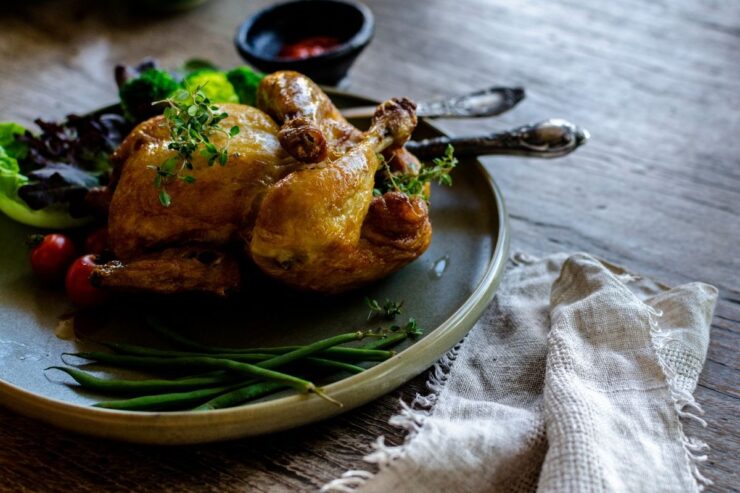
Cooked chicken can sit out at room temperature for up to two hours without compromising its safety. However, it is important to note that consuming cooked chicken within the first hour is recommended to minimize the risk of foodborne illness.
After the two-hour mark, it is advisable to refrigerate the cooked chicken to slow down bacterial growth and maintain its quality. Proper storage practices are crucial to ensure the safety of cooked chicken.
It should be stored in an airtight container to prevent contamination and placed in the refrigerator as soon as possible. If you plan to store the cooked chicken for a longer period, freezing is an option. When freezing cooked chicken, make sure to use airtight freezer bags or containers to maintain its texture and flavor.
It is worth noting that while cooked chicken can be safely consumed within two hours at room temperature, the same cannot be said for extended periods of time. Leaving cooked chicken out for too long increases the risk of bacterial growth, which can lead to foodborne illnesses.
To ensure optimal safety, it is always best to follow proper storage practices and consume cooked chicken within 3 to 4 days if refrigerated.
| Safe Time Limit for Cooked Chicken at Room Temperature | Storage Recommendations |
|---|---|
| Up to 2 hours | Consume within the first hour for best safety, refrigerate after 2 hours |
| 3 to 4 days | Refrigerate in an airtight container |
| Up to 6 months | Freeze in airtight freezer bags or containers |
By following these proper storage practices and being mindful of the time limits, you can ensure that your cooked chicken remains safe to consume and enjoy.
FAQ
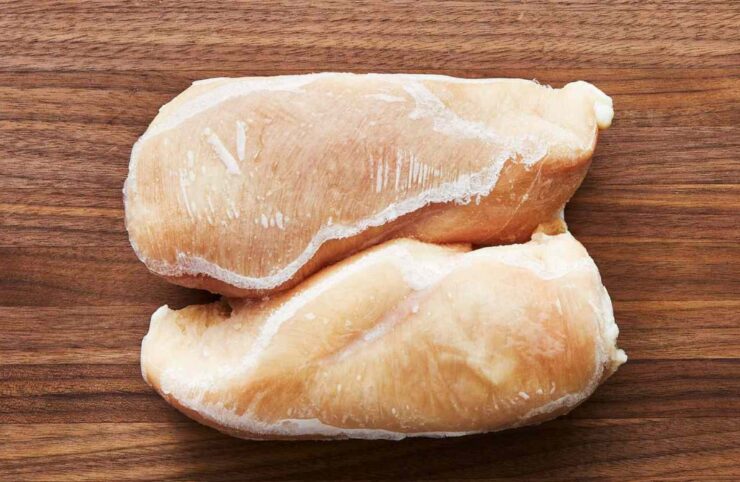
How long can raw chicken sit out? Until when is it safe?
According to the USDA, raw chicken should not be left out at room temperature for more than two hours. The time limit decreases to one hour if the temperature in the room is above 90°F.
Bacteria can start to multiply rapidly in the temperature range of 40°F to 140°F, known as the “danger zone.” Proper storage is essential to prevent bacterial growth and foodborne illnesses.
What is the danger zone for food?
The danger zone for food is the temperature range between 40°F and 140°F, where bacteria can rapidly multiply. Food left within this range for an extended period can lead to the production of toxins, causing food poisoning if consumed.
It is crucial to keep hot foods above 140°F and cold foods below 40°F to prevent bacterial growth and ensure food safety.
How should raw chicken be handled and stored?
Raw chicken should be stored in the refrigerator at a temperature of 40°F or below. It should be stored separately from other foods to prevent cross-contamination. Cooked chicken should also be stored properly, refrigerated within two hours of cooking, and consumed within four days.
If not consumed within four days, it can be safely frozen for up to six months. Thawing and reheating chicken should be done at safe temperatures to kill any bacteria.
What are the signs of spoiled chicken?
There are several signs of spoiled chicken to look out for, including changes in color (gray or greenish), slimy texture, unpleasant odor, and an expiration date that has passed. Other signs, such as mold or strange discoloration, should also be noted.
Consuming spoiled chicken can lead to food poisoning, with symptoms ranging from nausea and vomiting to dehydration. It is best to discard any chicken that shows signs of spoilage.
Can raw chicken sit out for 3 hours?
No, it is not safe to leave raw chicken out overnight. Raw chicken should always be stored in the refrigerator or freezer to prevent bacterial growth and foodborne illnesses. Bacteria can multiply rapidly at room temperature, increasing the risk of food poisoning if consumed.
For food safety, raw chicken should be properly stored and discarded if left out for extended periods.
Is it okay if raw chicken is left out overnight?
If raw chicken has been left out at room temperature for 24 hours or more, it is no longer safe to consume. Bacterial growth on raw chicken can happen quickly, especially in warm conditions, and it is not possible to determine visually or by smell whether the chicken has become contaminated.
To ensure food safety, raw chicken should be discarded if it has been left out for 24 hours or more.
What happens if raw chicken is left out for 24 hours?
If raw chicken has been left out at room temperature for 24 hours or more, it is no longer safe to consume. Bacterial growth on raw chicken can happen quickly, especially in warm conditions, and it is not possible to determine visually or by smell whether the chicken has become contaminated.
To ensure food safety, raw chicken should be discarded if it has been left out for 24 hours or more.
How long can cooked chicken sit out?
Cooked chicken can sit out at room temperature for up to two hours, but it is best to consume it within the first hour to reduce the risk of foodborne illness. After two hours, it is recommended to refrigerate the cooked chicken to slow down bacteria growth.
Cooked chicken should be stored in an airtight container and consumed within 3 to 4 days for optimal safety and quality.
Conclusion
Proper handling, storage, and temperature control are crucial for ensuring the safety of raw and cooked chicken. It is important to follow food safety guidelines to prevent foodborne illnesses and enjoy your chicken without any risks.
Raw chicken should never be left out at room temperature for more than two hours, as this allows bacteria to multiply rapidly. Cooked chicken should be consumed or refrigerated promptly, preferably within the first hour, to reduce the risk of foodborne illness.
Signs of spoiled chicken, such as changes in color, slimy texture, unpleasant odor, or an expired date, should never be ignored. Consuming spoiled chicken can lead to food poisoning, causing symptoms like nausea, vomiting, and dehydration.
Whether you are just looking for a quick meal, or a professional bodybuilder like Jeff Cavaliere, everyone who is looking to get some quick protein in form of chicken should know about safety practices before cooking and consuming it.
By practicing proper handling, storage, and temperature control, you can ensure that your chicken is safe to eat and enjoy. Remember to store raw chicken at the required temperature, separate it from other foods, and discard any chicken that shows signs of spoilage. By prioritizing food safety, you can enjoy delicious chicken dishes with peace of mind.
Related Posts:
- How Can I Find Out the History of a Car? Essential…
- Best Dad Jokes - Check Out This Collection of Funny…
- What Medical Conditions Qualify for Long-Term…
- How Long Does Arbitration Take: Legal Tips for a…
- How Long Should You Play Video Slots? Finding the…
- How to Properly Store Your Photo Book Collection to…
